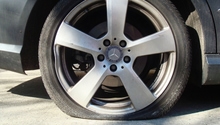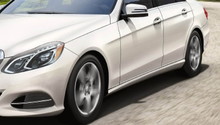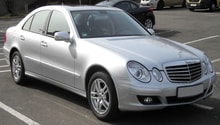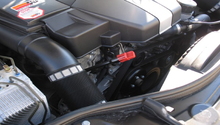Mercedes-Benz E-Class and E-Class AMG: Why is My Transmission Stuck in Park?
A transmission stuck in park may sound much worse than it really is in the Mercedes-Benz E-Class.
This article applies to the Mercedes-Benz E-class and E-Class AMG (2002-2009).
The design that all Mercedes-Benz E-Class automatic transmissions use is a "gear and lever/pawl" design. A gear is splined to the output shaft of the transmission. A lever is attached to a hinge pin and the hinge pin is grounded into the transmission case. When you put the shift lever into the "park" position, a complicated system of levers move the park pawl to engage the park gear. This action locks the transmission output shaft and prevents the car from moving. If the car is parked on a hill and the car is heavy, there is an extremely large torque being transferred from the park gear though the park pawl, and into the transmission case. Many times when you move the shift lever out of park you will hear a loud "BANG." This is startling to many people but it is actually completely normal. A transmission can be stuck in the park position because the car is parked up against a curb on a grade and a large percentage of the vehicle's weight is applied to the park system.

Materials Needed
- None
Step 1 – Check for proper operation of the shift lever park interlock solenoid
The shift lever has a "lock" solenoid that must release before the lever can be taken out of park. In order for the "lock" solenoid to release, the driver's foot must be firmly pressed on the brake pedal.
- While the engine is running, press your foot on the brake pedal.
- Gently move the shift lever out of the park position and into the desired driving position. You will be listening and feeling for a click near the shift lever. This click sound is the shift lever lock solenoid moving out of the "locked" position. If you do not hear or feel the click, repeat this step.
- If it appears the solenoid has failed, then it is necessary to replace the solenoid.
Step 2 – Ensure the car is not parked up firmly against a curb
If the car was driven up against a curb or concrete stop in a parking lot, it is possible the park lock lever can be locked into the park pawl with excessive force. When the car was parked up against the curb and the brake pedal was released, it's possible the car had moved up one inch towards the curb before the park lock mechanism was engaged inside the transmission. This action places extra vehicle weight on the park system and can make it difficult to disengage park.
- With your foot firmly on the brake pedal, move the lever out of park.
- Use more "muscle" than normal. Use as much force as necessary, unless you feel a hard stop; however, if it's slightly moving, force it out.
Step 3 – Check the brake light switch at the brake pedal
Have a helper tell you whether or not the brake lights are on when the brake pedal is pushed.
- Check operation of the brake lights with brake pedal pushed.
- If the lights don't turn on when the brake pedal is pressed, the switch may have failed.
- Replace the switch. It is located above the brake pedal.

Pro Tip
The park lock solenoid has just enough force to remove the park lock from the shift lever. As the parts wear, the force required to remove the park lock may increase. As you drive the car over time, it's important to not "force" the shift lever from the park position. If you feel resistance from the park lock, take it easy and start over. Your shift lever will thank you in the long run.
Related Discussion and Site
- Mercedes Benz Stuck in Park - MBWorld.org
- Mercedes Benz Stuck in Park - Benzworld.org






